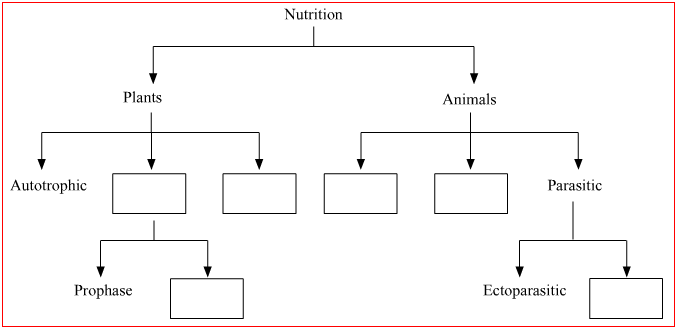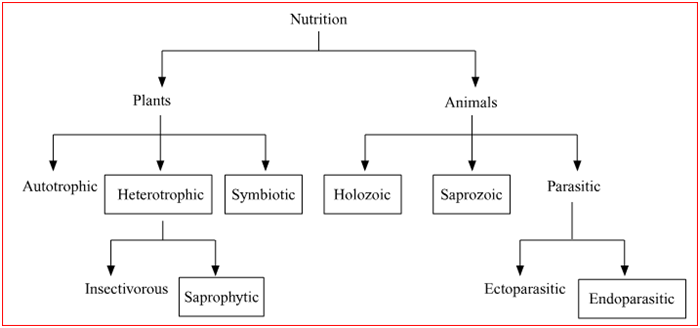Nutrition in living Organisms
Based on Maharashtra Board General Science Chapter 4
Solution
Question 1:
Classify according to food-type.
tiger, cow, vulture, bacteria, deer, goat, human, fungus, lion, sparrow, buffalo, frog, cockroach, tick.
Parasite
Carnivore
Herbivore
Omnivore
Decomposers
Scavenger
Tiger, Lion, Frog, Cockroach
Cow, Deer, Goat, Sparrow, Buffalo
Human
Bacteria, Fungus
Tick
Vulture
Question 2:
Match the pairs.
| Group 'A' | Group 'B' | ||
| (1) | Parasitic plant | (a) | Mushroom |
| (2) | Insectivorous plant | (b) | Lichen |
| (3) | Saprophytic plant | (c) | Drosera |
| (4) | Symbiotic plant | (d) | Cuscuta |
Group 'A'
Group 'B'
(1)
Parasitic plant
(d)
Cuscuta
(2)
Insectivorous plant
(c)
Drosera
(3)
Saprophytic plant
(a)
Mushroom
(4)
Symbiotic plant
(b)
Lichen
Question 3:
Answer the following questions in your own words.
(a) Why do living organisms need nutrition ?
Living organisms need nutrition for the following reasons : (1) For the continuous supply of energy to perform work. (2) To help in the growth and development of the body. (3) To replace the worn out tissue and to repair the damaged tissues. (4) To have resistance to infections and diseases
(b) Explain the process of production of food in plants.
(1) The plants prepare the food by the process of photosynthesis. Plants absorb water and minerals present in the soil with the help of roots. (2) The carbon dioxide is taken from the air and with the help of chlorophyll in the presence of sunlight, plant prepares glucose in the process of photosynthesis. (3) In the process oxygen is liberated by the plant. (4) Chemical reaction of the photosynthesis :

(c) What is meant by parasitic plants ? Name their different types with examples of each.
(1) The plants that depend on other plants for their nutrition are called parasitic plants. (2) The parasitic plants are heterotrophic in their mode of nutrition, Some of them lack chlorophyll and thus cannot perform photosynthesis on their own. (3) Loranthus is partial parasite. It sucks the nutrition from its host but prepares its own food. (4) Cuscuta or Dedder does not have chlorophyll. It looks yellow, wire like climber, Hence it is complete parasite on the host tree.
(d) Explain the various steps of nutrition in animals.
There are main five steps of nutrition in animals, viz, ingestion, digestion, absorption, assimilation and egestion.
(e) Name some unicellular organisms in which all life-processes take place within their unicellular body.
The unicellular organisms in which all life processes take place within their body are- Amoeba, Paramoecium and Euglena.
Question 4:
Give reasons.
(a) Insectivorous plants are attractively coloured.
Insectivorous plants feed on insects. They need to capture the insects. In order to attract these insects towards the plant, they are attractively coloured.
(b) Butterflies have a long tube-like proboscis.
Butterflies have a long tube like proboscis which is a straw-like structure which enables them to drink juices and nectar. It is coiled-up like a garden hose when it is not in use.
Question 5:
Prepare and complete the flowchart according to type of nutrition.


Question 6:
Think and answer.
(a) We prepare a variety of foodstuffs and dishes at home. Are we then autotrophic organisms ?
By preparing variety of foodstuffs and dishes at home, we do not become autotrophic. Autotrophic is a term which is used for organisms which can produce their own food. We humans depend on plants for our food and the products which we get from them are used by us to make a variety of foodstuffs. Also, autotrophic organisms contain chloroplast which is an absolute necessity to be classified as an autotroph and we do not possess any such structures. So, we cannot be considered autotrophs. We are Heterotrophs
(b) Which organisms are greater in number - autotrophs or heterotrophs ? Why?
Autotrophs are the organisms which are greater in number. It is because heterotrophs are dependant on autotrophs to meet their food requirements. If heterotrophs exceed the number of autotrophs, then all the autotrophs will vanish and so will be the heterotrophs. However, this is not the case because autotrophs are always more than heterotrophs so that they can help in sustaining the heterotrophs.
(c) The number of heterotrophs found in desert regions is smaller. However, they are found in greater numbers in the sea. Why is this so ?
(1) In desert region, the autotrophs are lesser in number as well as heterotrophs dependent on them are also less. (2) The food is scarce, therefore. the number of heterotrophs also reduces. (3) In oceans and seas there are multitude of zooplankton and phytoplankton, Phytoplankton are very small, microscopic floating plants which we may not see. (4) The food chain in the seas is dependent on these planktonic species. Therefore, the number of
heterotrophs found in desert regions is smaller but they are found in greater numbers in the sea.
(d) What damage or harm do ectoparasitic and endoparasitic animals cause ?
(1) Parasitic organisms depend on the host for its nutrition. (2) Ectuparasites have specialized mouth parts. With the help of these, they suck the blood. e.g. mosquito and bed bugs. The biting insects cause a lot of discomfort. (3) Mosquitoes spread many diseases such as malaria, dengue and elephantiasis. (4) Endoparasites live inside the body of host. (5) They absorb host's nutrients and cause malnourishment to the host. Both ectoparasites und endoparasites cause damage to our health.
e.g., Round worm. hook worm, pin worm etc.
(e) Why is plant food not produced in any other parts of the plant except the green ones ?
Plant food is produced by a special process known as photosynthesis. The process of photosynthesis requires specialized structures called chloroplasts and these structures are found only in green regions of plants. The green colour of specific parts of plants is due to the presence of chlorophyll pigment present in these chloroplasts. Structures in plants which do not contain chloroplast, do not appear green in colour and are not capable of producing food.
Class 7-General Science-Chapter-4-Nutrition in Living Organisms-Video
Click on below link to open video
1- [video_lightbox_youtube video_id="m2XKQNn75B8&rel=0" width="640" height="520" start="10" anchor="Part-1"]
2- [video_lightbox_youtube video_id="gcD6A0Af3pU&rel=0" width="640" height="520" start="10" anchor="Part-2"]
| Main Page : Class 7th MSBSHSE – General Science - All chapters notes, solutions, videos, test, pdf.
Books : Maharashtra Board-Class 7 Science Text Books – Chapter wise PDF for download Previous Chapter : Chapter 3 : Properties of Natural Resources - Online Solution Next Chapter : Chapter 5 : Food Safety - Online Solution |